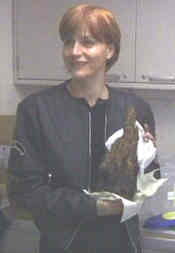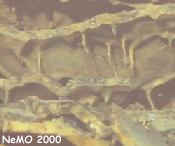| |
Participant
Interview:
Danielle Fortin
Geologist
University of Ottawa
Jeff: What kind of research
are you involved in at Axial Volcano?
Danielle: My research, now known as geo-microbiology, involves geology,
geochemistry and microbiology. So, I'm a confused person. I'm interested
in environments that contain bacteria, especially extreme environments.
In Axial I'm investigating the role of bacteria in mineral formation at
low temperature vents (around 4 øC) and away from vents on the ocean floor.
I'm researching how bacteria lead to the formation of minerals, especially
iron oxides, iron silicates, and manganese oxides.
Jeff: Why study their formation?
Danielle: Bacteria absorb and release elements, so if you want to understand
the cycling of those elements in the environment, you have to take into
account the role bacteria play. There is a lot of interest right now in
how bacterial cells, especially their cell walls, nucleate minerals from
dissolved elements.
Jeff: Every time the ROPOS
camera gets a shot of an iron oxide you get excited. What is so significant
about oxides containing iron?
Danielle: Iron
is the third most abundant element in the Earth's crust. It plays a major
role, like bacteria, in mineral formation by using its surface to immobilize
dissolved elements. If we have bacteria nucleating iron oxide, iron oxide
can immobilize trace elements.
Jeff: How did you get into
studying geo-microbiology?
Danielle: I was tired of looking at Ordovician rocks, which I thought
were too old. I wanted something recent so I went into studying things
that are, say, 3 months old. That's why I turned to recently formed environments
like the vents. They are forming as we speak.
|
|

Danielle Fortin holding
a sulfide spire with iron oxides.

Edge of ledge at Magnesia Vent (now inactive) showing lava drip structures
and some iron oxides at the lower edge. (ROPOS
2000)
|
|

